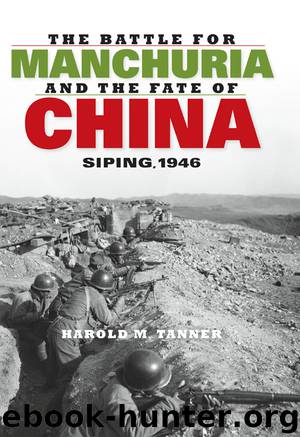The Battle for Manchuria and the Fate of China by Harold M. Tanner

Author:Harold M. Tanner
Language: eng
Format: epub
Publisher: Indiana University Press
STALEMATE AT SIPING (28 APRIL–14 MAY 1946)
At Siping, the suspension of the Nationalist attack after 27 April stretched out into eighteen days of stalemate. This did not mean that life in the city returned to normal or even that the shooting stopped. The two sides, Communist and Nationalist, took the opportunity to replenish their supplies, to repair and strengthen their defenses, and to ready themselves for the expected resumption of hostilities. Both sides made attempts at psychological warfare. Nationalist airplanes dropped propaganda pamphlets urging Communist soldiers to surrender. (Some soldiers later recalled having used these as toilet paper.) The Communists, for their part, used megaphones to shout at the Nationalist soldiers, “Chiang army brothers, don’t fire! Does your conscience let you kill ordinary Northeasterners? Listen to some Cantonese music!” These would be followed by gramophone recordings of Cantonese music—an attempt to make the Cantonese troops of the New First Army homesick.12
The shouting and the music could be heard because the Nationalists dug a system of trenches that allowed them to approach within fifty meters of the Communist front lines. From these trenches, they launched rapid probing attacks by night in order to identify weak points in the Communist defenses. The Communist troops often failed to station enough sentries along their front lines and found themselves getting into sudden, unexpected firefights.13 There was shooting every day, bombing, and even the occasional artillery duel as the two sides continued to test each other’s resolve and probe each other’s weak points. In one of these actions, the Communist troops drove a Nationalist unit out of a forward position—a red building on the edge of Siping. In another one, the commander of the Communist Seventh Division decided, on his own accord and without even notifying the units adjacent to his, that he would wipe out a newly arrived Nationalist division which had just taken a position on a nearby hilltop. As they tried to maneuver their way up to the enemy position through the gullies by night, the Communist soldiers lost their way. When dawn broke, they were fully exposed to enemy fire and had soon taken over one thousand casualties. Lin Biao was furious. His verdict: “This is the way small-time guerrillas attack the enemy.”14
In the context of this ongoing low-grade warfare, Liu Baiyu, a reporter for the Communist Party’s mouthpiece the People’s Daily newspaper, made a visit to Siping and the surrounding area. Liu’s report is certainly biased and strikes an optimistic note (from the Communist point of view), but it is perhaps the only extended description of the situation in Siping at the time to make it into the public record. In his account, Liu Baiyu described the intense fighting that the city had endured over the course of the first fifteen days of battle—artillery fire at up to 3,500 shells in two hours, civilians killed and injured and houses destroyed. But he also notes with pride that “up to today, Siping’s electricity and water have not been stopped even once.”
Download
This site does not store any files on its server. We only index and link to content provided by other sites. Please contact the content providers to delete copyright contents if any and email us, we'll remove relevant links or contents immediately.
| Africa | Americas |
| Arctic & Antarctica | Asia |
| Australia & Oceania | Europe |
| Middle East | Russia |
| United States | World |
| Ancient Civilizations | Military |
| Historical Study & Educational Resources |
The Alienist by Caleb Carr(1753)
The Analects of Confucius by Burton Watson(1379)
On China by Henry Kissinger(1304)
China in Ten Words by Yu Hua(1174)
The Last Kings of Shanghai by Jonathan Kaufman(1165)
One Bright Moon by Andrew Kwong(1155)
The Snakehead: An Epic Tale of the Chinatown Underworld and the American Dream by Patrick Radden Keefe(1062)
Deng Xiaoping and the Transformation of China by Vogel Ezra F(995)
Mao's Last Dancer by Li Cunxin(978)
Three Tigers, One Mountain by Michael Booth(967)
Seven Years in Tibet by Heinrich Harrer(950)
Midnight in Peking by Paul French(932)
Big Sister, Little Sister, Red Sister by Jung Chang(898)
Tiger Trap by David Wise(880)
Ancient Chinese Warfare by Ralph D. Sawyer(813)
Modern China. A Very Short Introduction by Rana Mitter(794)
China Men by Maxine Hong Kingston(790)
The Open Road by Pico Iyer(768)
Riding the Iron Rooster by Paul Theroux(754)
